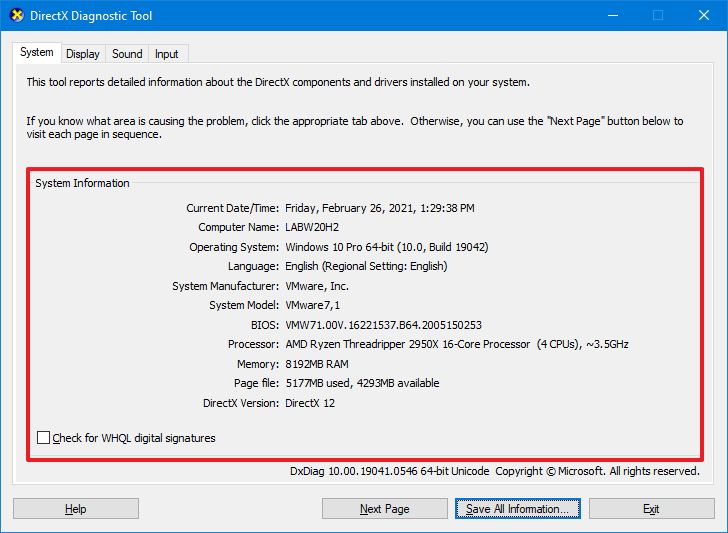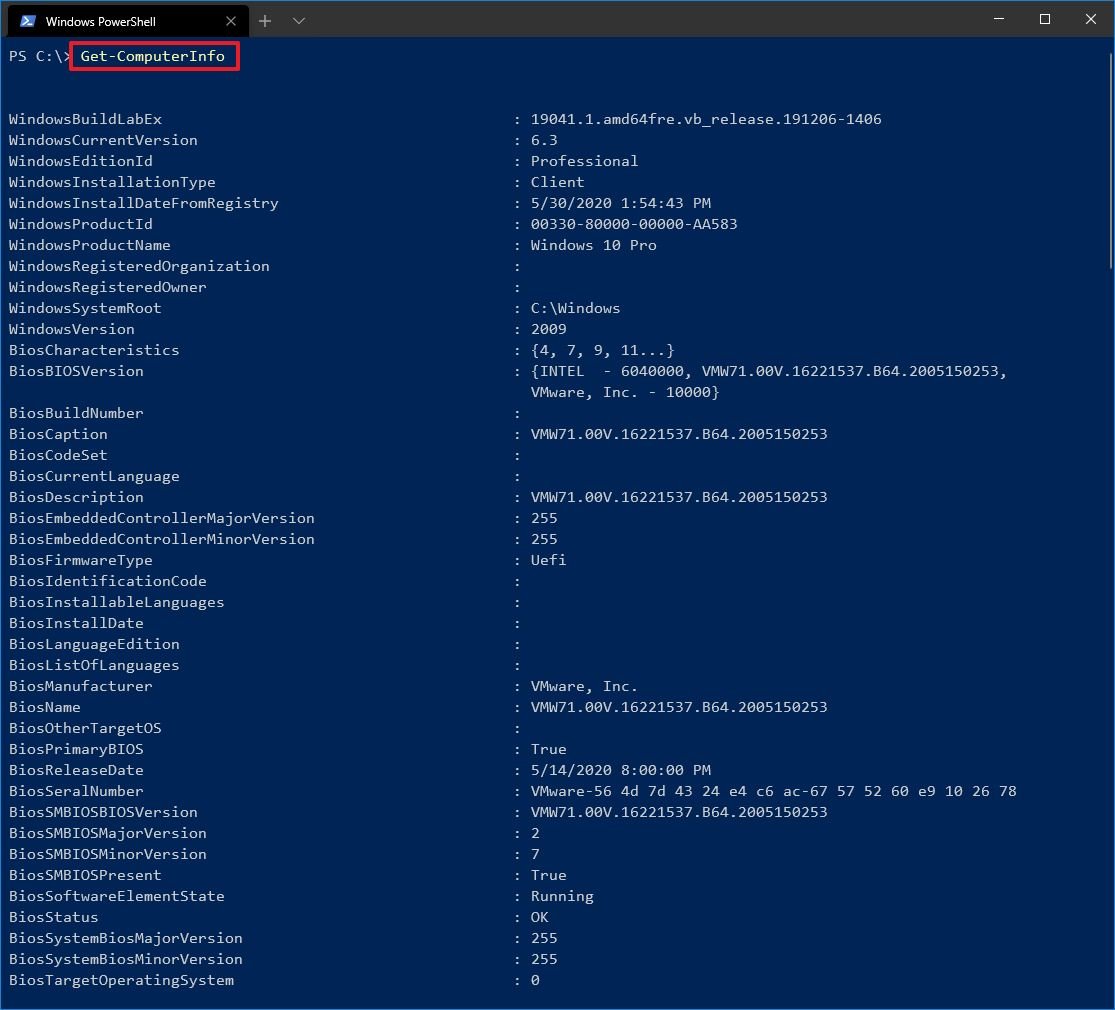How to See Your Specs on Windows 10
Previous 1 of 5
 Source: Windows Central
Source: Windows Central
On Windows 10, the ability to view a computer's specs can come in handy in many situations. For example, it can be useful to determine if the device meets the minimum requirements to install a piece of software. If the computer is not working, and you have to troubleshoot a problem. Or, if you are noticing the device is getting slower over time, knowing the hardware specifications can help confirm whether you need to upgrade a component or it is time to replace the machine.
Whatever the reason it might be, Windows 10 has several ways to check the PC specs, such as processor, memory, motherboard, graphics card, Basic Input/Output System (BIOS) or Unified Extensible Firmware Interface (UEFI), device model number, drivers, updates details, and Windows version, using desktop applications or command-line tools. The only caveat is that depending on the method, the properties available could be slightly different.
In this Windows 10 guide, we will walk you through the steps to check your device's full hardware and software specifications.
- How to find computer specs using Settings
- How to find computer specs using System Information
- How to find computer specs using DirectX Diagnostic Tool
- How to find computer specs using PowerShell
- How to find computer specs using Command Prompt
How to find computer hardware specs using Settings
If you only need the basic system specifications, such as the processor, memory, and Windows details, you can find this information inside the "About" settings page.
To check the computer tech specs with the Windows 10 Settings app, use these steps:
- Open Settings.
- Click on System.
- Click on About.
-
Under the Device specifications section, check the processor, system memory (RAM), architecture (32-bit or 64-bit), and pen and touch support.
 Source: Windows Central
Source: Windows Central - Under the Windows specifications section, check the software specifications:
- Edition – Shows if you have Windows 10 Pro or Windows 10 Home.
- Version – Reveals the Windows release currently on the computer and the version changes with every semi-annual update you install.
- Installed on – States the date when the last feature update was installed.
- OS build – Indicates the technical build number of the Windows release, where the first five numbers represents the version and anything after the period represents the latest quality update installed on the device.
-
Experience – Reveals the service feature pack installed on the device.
 Source: Windows Central
Source: Windows Central
Once you complete the steps, you will have a clearer understanding of the computer's basic technical specifications.
While on the "About" page, you can also click the Copy button under each section to copy and share the specifications with other people, safe for future reference, or inventory.
Previous 1 of 5
2 of 5

1. ExpressVPN: The best VPN available right now
This is our top pick for anyone looking to get started with a VPN. It offers a great mix of speed, reliability, outstanding customer service, and affordability. There is a 30-day money-back guarantee, so give it a shot today.
From $6.67 per month at ExpressVPN
How to find computer specs using System Information
On Windows 10, the System Information is a legacy application that is one of the best options to view a complete x-ray of the device's technical specifications.
To view all the hardware specs of the computer, use these steps:
- Open Start.
- Search for msinfo32 and click the top result to open the System Information app.
-
Select the System Summary category from the left navigation pane.
 Source: Windows Central
Source: Windows Central - On the right side, confirm the computer specs, including system model and type, processor brand and model, UEFI (or legacy BIOS) version and other details, system memory capacity, motherboard brand and model, and virtualization support.
- (Optional) Expand the Components branch.
-
Select the Display option to view the graphics card technical information.
 Source: Windows Central
Source: Windows Central
After you complete the steps, you will have a detailed overview of the laptop or desktop specs.
If you need to check specific details about a component, the System Information tool offers a search option at the bottom of the page to quickly find the information you need. (This is not your regular search experience, which means you must use exact text queries to get the result you want.)
Create hardware specs report on Windows 10
The System Information app also includes an option to create a report with the hardware and software tech specs, which you can save to refer later, inventory, or share with technical support to troubleshoot an issue.
To create a report with the system specs on Windows 10, use these steps:
- Open Start.
- Search for msinfo32 and click the top result to open the System Information app.
-
Select the specifications to export from the left navigation pane.
Quick tip: Selecting System Summary will export everything. However, if you only need to export the graphics card details, you only need to select the Display item from the left navigation pane.
- Click on the File menu.
-
Click the Export option.
 Source: Windows Central
Source: Windows Central - Select the folder to export the file.
- Confirm a descriptive name for the report – For example, "Windows 10 PC specs".
- Click the Save button.
- Open File Explorer.
- Navigate to the folder containing the exported information.
-
Right-click the text file and select the open option to view the exported system information.
 Source: Windows Central
Source: Windows Central
After you complete the steps, the specifications will export into a text file, which you can then open with any text editor.
2 of 5
3 of 5
How to find computer specs using DirectX Diagnostic Tool
Windows 10 also includes the DirectX Diagnostic Tool (dxdiag) to view information about DirectX sound and video support to help you troubleshoot different system problems. However, you can also use it to determine many tech specs about the machine, like the information available through the "About" settings page.
To check the computer specs with the DirectX Diagnostic Tool, use the steps:
- Open Start.
- Search for dxdiag and click the top result to open the DirectX Diagnostic Tool.
- Click on the System tab.
-
Under the "System information" section, check the computer tech specs, including processor, memory, BIOS or UEFI version, system model and manufacturer, Windows 10 version and edition, and more.
 Source: Windows Central
Source: Windows Central - Click the Display tab.
-
Under the "Device" section, check the graphics card technical specs like name and manufacturer, graphics memory, and display details.
 Source: Windows Central
Source: Windows Central -
(Optional) Click the Save All Information button.
 Source: Windows Central
Source: Windows Central - Select the folder destination.
- Confirm a descriptive name for the report – For example, "Windows 10 PC specs".
- Click the Save button.
- Open File Explorer.
- Navigate to the folder containing the exported information.
-
Right-click the text file and select the open option to view the exported system information.
 Source: Windows Central
Source: Windows Central
Once you complete the steps, you will end up with a text file, properly formatted, with all the computer hardware and software details.
3 of 5
4 of 5
How to find computer specs using PowerShell
Alternatively, you can also use PowerShell to determine the technical specifications of your device.
To use PowerShell to check the computer tech specs, use these steps:
- Open Start.
- Search for PowerShell, right-click the top result, and select the Run as administrator option.
-
Type the following command to determine your computer specs and press Enter:
Get-ComputerInfo Source: Windows Central
Source: Windows Central -
(Optional) Type the following command to view only the details of a specific component and press Enter:
Get-ComputerInfo -Property "PROPERTY-NAME"In the command, change PROPERTIES-NAME for the details you want to review.
For example, the following command displays everything regarding the BIOS information:
Get-ComputerInfo -Property "bios*" Source: Windows Central
Source: Windows Central Quick note: The asterisk
*in the command syntax is a wildcard to match every property that starts with BIOS.
After you complete the steps, PowerShell will display a full list of Windows 10 and hardware information or the specific property you requested in the command.
4 of 5
5 of 5 Next
How to find computer specs using Command Prompt
If you want to check the computer specs with Command Prompt, you can use the System Information (systeminfo) command tool, which allows you to view even more hardware and software details than the UI version of the app.
To find the computer specs with Command Prompt, use these steps:
- Open Start.
- Search for Command Prompt, right-click the top result, and select the Run as administrator option.
-
Type the following command to find your device specs and press Enter:
systeminfo Source: Windows Central
Source: Windows Central Quick tip: Use the
systeminfo /?command to see the available options using this tool in Command Prompt.
Once you complete the steps, the command output will return all the information about the computer's hardware and software, including Windows 10 and update information, system architecture, whether the device uses BIOS or UEFI, RAM, and network details.
If you want to save the output received from PowerShell or Command Prompt commands to a text file, you can use these instructions.
More Windows 10 resources
For more helpful articles, coverage, and answers to common questions about Windows 10, visit the following resources:
- Windows 10 on Windows Central – All you need to know
- Windows 10 help, tips, and tricks
- Windows 10 forums on Windows Central
We may earn a commission for purchases using our links. Learn more.

Save on Xbox gear
Best Cyber Monday Xbox Series X deals 2021
Stock of the Xbox Series X will still be hard to find on Cyber Monday but there will be plenty of other items on offer. We're expecting big reductions on some top-of-the-line gaming headsets and if you've been looking to upgrade your storage there will be SSD and HDD offers galore. Controllers, Game Pass, and even TVs all feature too.
5 of 5 Next
How to See Your Specs on Windows 10
Source: https://www.windowscentral.com/how-check-your-computer-full-specifications-windows-10












